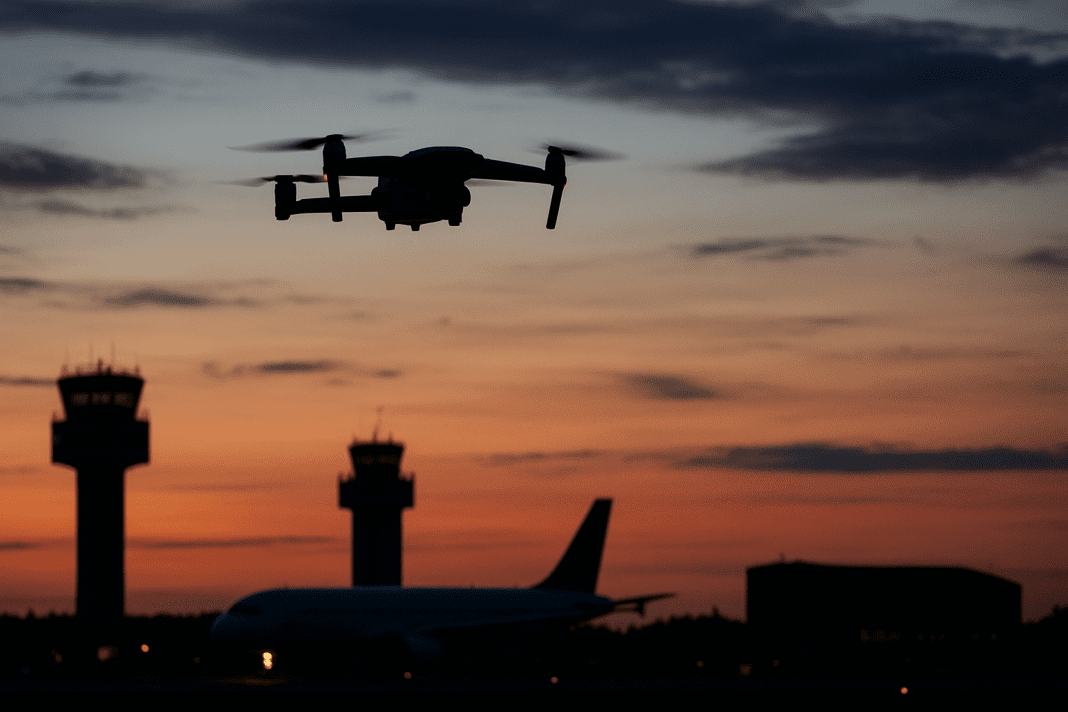Denmark faced a wave of Denmark drone attacks across Jutland, the western part of the country, causing brief airport closures and exposing the nation’s vulnerability. Aalborg and Billund airports were forced to halt operations temporarily, while drones were also reported at Esbjerg, Sonderborg, and Skrydstrup. Aalborg hosts a military base, and Skrydstrup is home to Denmark’s F-35 and F-16 fighter jets. The Jutland Dragoon regiment in Holstebro also reported drone activity.
Widespread Denmark Drone Attacks Disrupt Airports and Military Sites
Authorities reported that the drones caused no harm or damage. Yet, the incidents have raised concerns about Denmark’s critical infrastructure and military readiness. Following the initial sightings, Aalborg airport briefly closed again due to another suspected drone.
Reports also emerged of drone activity near oil and gas platforms in the North Sea and around Korsor, a central port. These areas are considered vital for the country’s economy and energy supply. Despite the multiple locations affected, none of the drones have been shot down, as authorities decided it was safer to let them fly. These Denmark drone attacks have triggered national discussions about airspace security and defense capabilities, highlighting the risks posed even by unarmed drones.
NATO on edge as wave of drone incursions hit Denmark, Norway, and Eastern Europe
Officials noted that allowing the drones to continue flying was a calculated decision. Shooting them down could have caused debris to fall onto populated areas or sensitive installations. Experts agree that these incidents, while not causing physical harm, exposed gaps in Denmark’s surveillance and response systems.
Military and Police Respond with Caution to Denmark Drone Attacks
Denmark’s approach to the Denmark drone attacks has been cautious and strategic. Defense chiefs emphasized the risks associated with shooting drones down over airports, towns, or military zones. When a drone is destroyed mid-air, its debris can fall uncontrollably and cause fires or injuries. A recent example in Poland showed how missile debris destroyed a house after being shot down during an airspace breach.
Police stated they would attempt to bring down drones only if it could be done safely. Military officials clarified that intervention could occur over military installations, but decisions would depend on threat assessments and potential consequences.
Copenhagen puts Brussels on edge: Denmark backs tariffs and trade suspensions against Israel
Experts in drone technology highlight that these incidents revealed significant gaps in Denmark’s defense systems. Deploying drones is simpler and cheaper than developing tools to detect, track, and neutralize them. The fact that drones were able to operate undisturbed across multiple locations raises questions about the country’s airspace monitoring capabilities.
Denmark’s response contrasts sharply with neighboring countries. Poland has taken a direct approach by shooting down drones after multiple incursions. Other NATO members, including Norway, Estonia, Bulgaria, and Romania, have faced hybrid warfare incidents in recent weeks. Estonia and Poland invoked NATO’s Article 4 after Russian drones and aircraft entered their airspace. Denmark is currently assessing whether to take similar measures in response to the Denmark drone attacks, although no formal decision has been made.
Hybrid Warfare Raises Alarm Across the Region
Authorities described the Denmark drone attacks as a systematic operation, possibly part of hybrid warfare targeting multiple locations. While the exact actors remain unidentified, authorities noted that these incidents could be intended to test the country’s response capacity. Russia has not been ruled out, but Moscow denies involvement.
The incidents prompted rapid government and military briefings. The Defense Ministry highlighted the seriousness of the attacks and the challenges they pose to national security. Security levels in Jutland were raised, and military officials emphasized that Denmark faces a new reality regarding airspace defense and drone monitoring.
Denmark steps in with billion-crown lifeline to ease Greenland’s economic and healthcare crisis
Plans for an “integrated layered air defense” and investment in long-range precision weapons have been announced. However, these systems are not yet operational, leaving Denmark vulnerable in the short term. Discussions are ongoing with NATO allies and the European Union about establishing a “drone wall,” an early detection system aimed at protecting borders from armed drone incursions.
Even though the drones observed were unarmed, the incidents emphasized vulnerabilities across airports, military bases, and key infrastructure sites. The Denmark drone attacks have prompted authorities to reassess safety measures, increase monitoring, and strengthen coordination between police and the military. The events have provided a stark wake-up call, highlighting the need for stronger drone detection and rapid response mechanisms to safeguard Denmark’s critical infrastructure.

